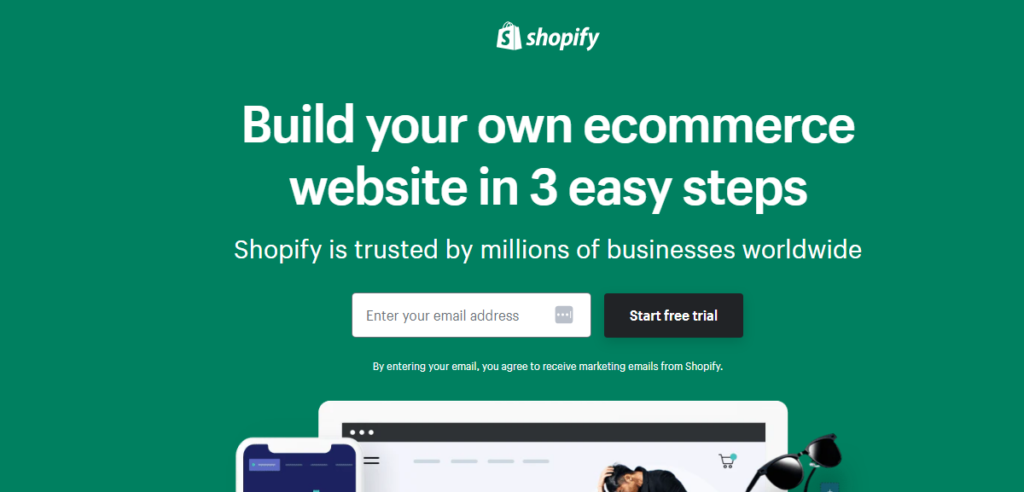Shopify is like a real market but online. Shopify is a lively place with more than 4.8 million online shops! It’s like a huge global marketplace where you can start your own store.
Shopify is not only popular in big countries like the United States, the United Kingdom, and Australia, but it’s also growing in other places like Canada. There are already over 109,000 Shopify stores in Canada alone! So, no matter where you are, you can be part of this online world.
And guess what? You can sell all kinds of things on Shopify, from clothes to jewelry, bags, shoes, and even stuff like home decorations, fitness gear, and special things like coffee and kitchen items. There’s an opportunity for everyone!
If you dream of having your own online store, this is your chance. Let’s explore how to make a successful Shopify store in 2024, step by step. Are you ready? Let’s get started!
Setting Up Your Shopify Store
Setting up your Shopify store is the first exciting step towards your online business journey. Let’s discuss in detail:
Create an Account on Shopify
To start e-commerce through Shopify, the first step is to create your Shopify account. You can try Shopify for free with their trial offer. This will give you a taste of what it’s like to run your own online store without any initial financial commitment.

To set up a Shopify store begins with signing up for an account. The process is user-friendly and doesn’t require any extra costs. This 3 months trial period for $1 per month allows you to explore the platform, get familiar with its features, and understand the process of running an online business.
Choosing the Right Theme
Your store’s design is important for attracting and retaining customers. Shopify has various themes for your store, both free and premium. Make sure to pick a theme that is related to your brand and target audience. You can customize your store to make it unique and attractive.

Once you’ve created your Shopify account, the next step is to choose the right theme for your online store. It’s the first thing your customers will see, and it sets the tone for their shopping experience.
Naming Your Store
The store name is like your brand’s identity. It should be memorable and reflect your business. Take your time to brainstorm and choose a name that will fit your business.
Your store’s name is not just a string of characters; it’s your brand’s identity. It’s what customers will remember, share, and associate with your products or services.
Adding Products to Your Shopify Store – Boost Your Online Visibility
Adding products to Shopify store is an easy process but a little bit tricky so let’s explore:
Product Descriptions That Convert
When it comes to adding products to your Shopify store, writing compelling product descriptions is an art. These descriptions should not be just words on a page; they should be your virtual salesperson. Here’s how to make them SEO-friendly and irresistible to potential buyers:
- Detailed and Engaging: Your product descriptions should leave no room for ambiguity. Use detailed language to describe your products’ features and benefits. Imagine you’re talking to a customer face-to-face, explaining why your product is a game-changer.
- Keyword Optimization: Incorporate relevant keywords that potential customers might use when searching for products like yours. This will help your products rank higher in search engine results. Be sure to use keywords naturally, without overstuffing.
- High-Quality Images: A picture is worth a thousand words, and in e-commerce, it’s worth even more. Pair your descriptions with high-quality images that showcase your products from different angles. Images should be clear, well-lit, and zoomable.
- User Reviews: Encourage customers to leave reviews and ratings for your products. Positive reviews can boost your credibility and attract more buyers. Respond to reviews promptly to show that you value customer feedback.
Know Your Target Audience Inside Out
Understanding your target audience is not just a buzzword; it’s the secret sauce to e-commerce success. Here’s how to tailor your product listings to their unique needs and preferences:
- Market Research: Dive deep into market research to identify your ideal customers. What are their pain points? What solutions are they seeking? Knowing this will help you curate products that resonate with them.
- Create Buyer Personas: Develop detailed buyer personas representing different segments of your target audience. Give them names, ages, and interests. This makes it easier to create product listings that speak directly to these personas.
- Personalized Product Suggestions: Use data from your Shopify store to recommend products based on customers’ browsing and purchase history. Personalized suggestions can significantly increase sales.
The Power of Free Shipping
Free shipping is like a magnet for online customers. It can be a game-changer for your Shopify store. Here’s how to apply it:

- Strategic Promotions: Consider offering free shipping as part of limited-time promotions or for orders above a certain amount. This not only boosts sales but also encourages customers to add more items to their carts.
- Transparent Policies: Clearly communicate your free shipping policies. Make sure customers know the conditions, such as minimum order amounts or delivery times. Transparency builds trust.
- Abandoned Cart Recovery: Implement an abandoned cart recovery strategy that includes reminders about free shipping. Sometimes, all it takes is a gentle nudge to convince customers to complete their purchase.
Driving Traffic to Your Store
You’ve set up your Shopify store, chosen the perfect theme, and given it a catchy name. Now, it’s time to get customers to your online store. Shopify offers various tools and strategies to help you achieve this.
Shopify Apps
One of the key advantages of using Shopify is its extensive ecosystem of apps. These apps can be a game-changer when it comes to driving traffic to your store. Whether you’re looking to boost your marketing efforts, enhance your store’s SEO, or integrate seamlessly with social media platforms, there’s likely an app for that.
Exploring the Shopify App Store
To get benefit from the power of these apps, go to the Shopify App Store. Here, you’ll find a vast collection of both free and premium apps designed to address a wide range of e-commerce needs. Let’s take a closer look at some categories of apps that can help you drive traffic:
Marketing Apps
Marketing is very important for any successful online store. Fortunately, there are numerous marketing apps available. These apps can help you create and manage email marketing campaigns, automate social media posts, and even run pay-per-click advertising campaigns.
SEO (Search Engine Optimization) Apps
Appearing at the top of search engine results is crucial for driving organic traffic to your store. SEO apps can help you optimize your product listings and website content to rank higher in search engine results pages (SERPs). They provide insights and suggestions to improve your website’s SEO, making it easier for potential customers to discover your store when they search for related products or services.
Social Media Integration Apps
Social media is a powerful tool for driving traffic and engaging with your audience. Shopify offers integration with popular social media platforms like Facebook, Instagram, and Pinterest. Specialized apps can help you seamlessly connect your store with these platforms, allowing you to showcase your products, run targeted ads, and tap into the vast social media user base.
Marketing Your Store
Marketing is the bridge that connects your store to potential customers. It’s how you let the world know about your products or services, and Shopify provides you with the tools to make a strong marketing impact.
Social Media Marketing
Using social media platforms such as Facebook, Instagram, Twitter, and Pinterest are effective in reaching a wider audience. Create engaging content, post regularly, and use relevant hashtags to increase your store’s visibility. Consider running paid ad campaigns on social media to target specific demographics and interests.
Email Marketing
Email marketing is a tried-and-true method for engaging with your audience. Collect email addresses from your customers and website visitors, then use email marketing platforms to send out newsletters, promotions, and product updates. Personalize your emails to make your customers feel valued and informed.
Click here: Free Email Marketing Course
Promotions and Discounts
Running promotions and offering discounts can be a powerful incentive for customers to visit your store. Consider offering limited-time discounts, free shipping, or buy-one-get-one (BOGO) deals. Highlight these offers prominently on your website and in your marketing materials to attract new customers and encourage repeat business.
Ensuring Success
You’ve embarked on the journey to create a successful Shopify store in 2024, and as you navigate this digital landscape, there are key strategies and practices you must implement to ensure your store’s success. Let’s delve into these crucial aspects:
Optimize Your Store
Optimizing your Shopify store is akin to fine-tuning a well-oiled machine. It’s all about enhancing every facet of your online presence to provide an exceptional shopping experience for your customers.
Site/Store Speed
Website speed is paramount in today’s fast-paced online world. Slow-loading pages can deter potential customers and lead to high bounce rates. Regularly check and optimize your site’s speed by compressing images, leveraging browser caching, and using content delivery networks (CDNs). A fast-loading store not only improves user experience but also positively impacts your search engine rankings.
Navigation
Smooth navigation is the roadmap that guides visitors through your store. Ensure that your website’s menu is intuitive and organized. Implement clear categories and product descriptions. Make it easy for customers to find what they’re looking for, and consider adding a search bar for quick access to specific items.
Seamless Checkout Process
A seamless checkout process is the final step in converting visitors into customers. Minimize friction during checkout by offering multiple payment options, simplifying the form fields, and providing transparency regarding shipping costs and delivery times. Test the checkout process yourself to identify any potential issues and streamline it for a hassle-free experience.
Analyze Your Data
Data is the compass that helps you navigate the e-commerce landscape effectively. Shopify offers powerful analytics tools that provide valuable insights into your store’s performance.
Sales Data
Keep a close eye on your sales data. Analyze which products are selling well and which ones may need additional marketing efforts. Identify peak sales periods and strategize promotions or discounts accordingly. Data-driven decisions can optimize your product offerings and pricing.
Customer Behavior
Understanding how customers interact with your store is crucial. Analyze customer behavior data to identify trends, such as popular product categories, abandoned carts, and customer demographics. Use this information to tailor your marketing campaigns and product recommendations.
Website Traffic
Monitor your website traffic to gain insights into visitor demographics, referral sources, and popular landing pages. This data can help you refine your content, target specific audiences, and allocate marketing resources effectively.
Click Here for: How to increase traffic
Building a Brand
Your Shopify store is not just an online marketplace; it’s a brand that represents your unique identity in the e-commerce world. Building a brand is a long-term investment that can set you apart from competitors and foster customer loyalty.
Brand Identity
Invest in your store’s brand identity, starting with a memorable logo and a consistent aesthetic. Your brand should reflect your values, mission, and the essence of your products or services. A strong visual identity can leave a lasting impression on customers and make your store more recognizable.
Brand Consistency
Consistency is key when building a brand. Ensure that your brand’s visual elements, messaging, and tone are consistent across your website, social media profiles, email communications, and packaging. This consistency reinforces your brand’s identity and builds trust with customers.
Conclusion:
Starting a Shopify store to do e-commerce in 2024 is an exciting opportunity. With over 4.8 million active stores, Shopify offers great potential. To succeed, follow these steps: Create your Shopify account with a free trial, choose a theme that matches your brand, and pick a memorable store name.
Bring traffic through Shopify apps and marketing efforts. Optimize your store for speed and user-friendliness, analyze data for insights, and build a unique brand identity. Success may take time, but with dedication and creativity, your Shopify store can grow in this competitive online world. Good luck!


